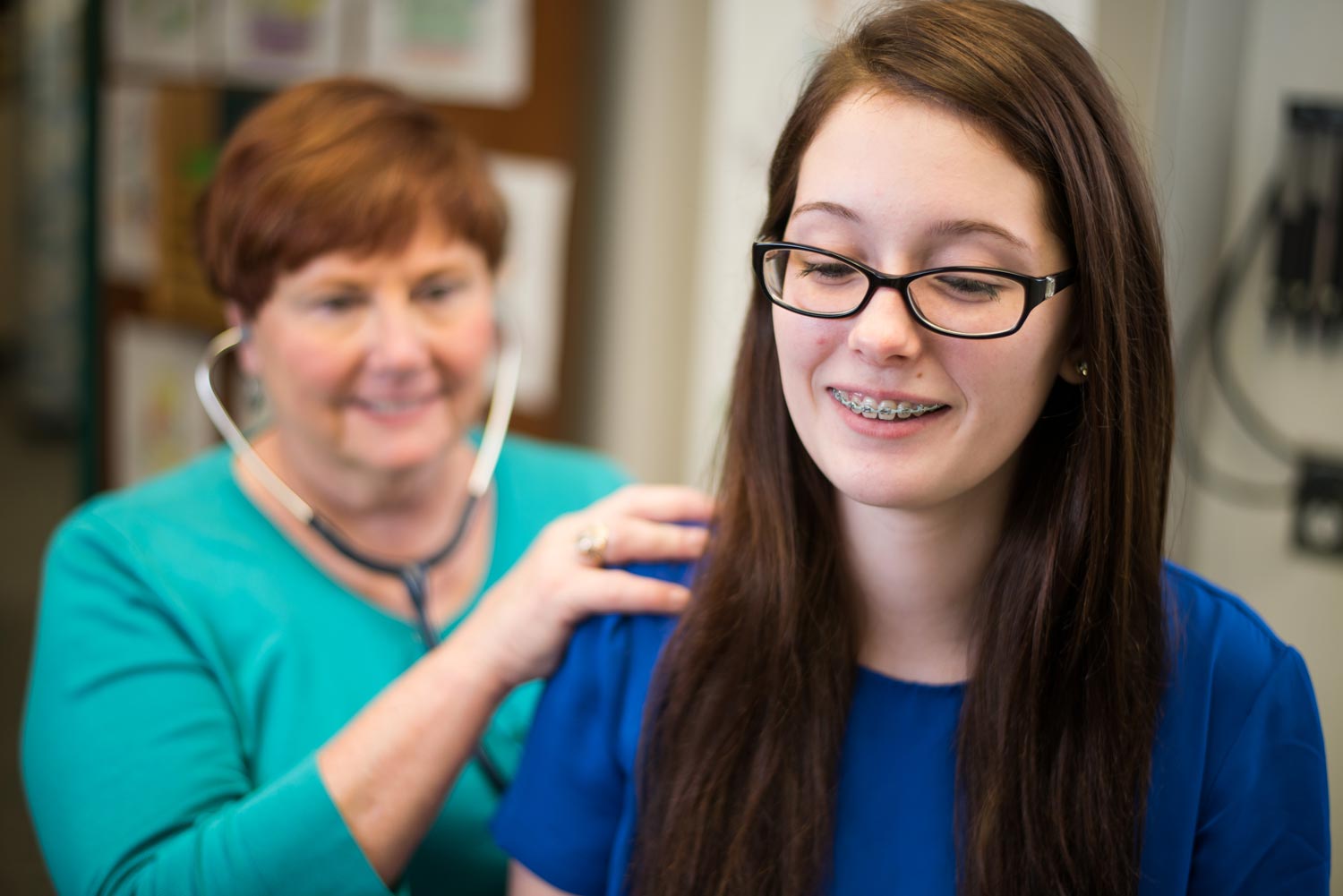
The practice has been carefully designed with both young children and adolescents in mind. Some exam rooms cater to teens, with adult-sized exam tables, and are absent of overly-childish themes. And, while caring for adolescents is an implicit part of every pediatric practice, Dr. Pillsbury chose, in planning every detail including the name of the practice, to give this at-risk patient population special attention. “We made the decision from the start to put ‘adolescent’ in the name so parents know their teenager is an important part of the practice.” One of the benefits of having a small, independent practice is the ability to make choices that will result in better clinical care for patients.
Each of these small decisions is part of a larger strategy to create a Patient-Centered Medical Home for the family, so that when children reach adolescence they continue to utilize their pediatrician for important preventive care. Dr. Pillsbury said that while it’s very rewarding to take care of someone from birth to college, it can be difficult to do so, with teens frequently underutilizing clinicians. Data shows that a drop-off for adolescent well visits begins at age 12, as the percentage of patients up-to-date decreases with each year they are active in the practice. Fewer than half of all 16 year olds have had a well visit in the last year.1
With adolescents making up a whopping 20 percent of the population, getting them in for regular well visits is an opportunity for pediatric practices to improve both clinical care and their bottom line. While adolescent well checks are time-consuming and often not as well paid as other types of visits, they’re an important part of creating a Patient-Centered Medical Home and are often an opportunity to generate previously unrealized income.
The Battle of Convenience
In the past, part of the decline in well visits for adolescents and teens could be explained by a lack of insurance coverage. In 2008, one in seven adolescents ages 10 to 18 had no form of public or private health insurance, but with the advent of the Affordable Care Act, most people now have some form of health insurance, even though their deductible may be high.2 That insurance usually includes coverage for preventive care, including at least one well-child visit per year.
“While a clinic may offer a ‘sports physical’ for $35 or $50, it may sound a lot cheaper than what I’m going to do it for, but it’s the same cost to parents if their insurance pays for a comprehensive exam they’ll get from their pediatrician,” she said. “Parents aren’t really aware of the kinds of developmental counseling we do.”
But, the problem isn’t just that teens aren’t going in for well visits. It’s that if they are, they’re likely receiving “sports physicals” at either school-based health clinics or urgent care facilities and not from their pediatrician. “I’m not sure if it’s because of a lack of understanding, or if it’s encouraged by schools, but it seems to me that a lot of these kids are getting their exams at a school-based health clinic,” said Dr. Pillsbury. “Parents think that if their teen can get the same exam at school or an urgent care facility, they don’t need to bother making an appointment and bringing them to the pediatrician. It’s not convenient.” With no appointments needed at an urgent care facility, the temptation is strong for many busy parents to skip an in-depth well visit with their child’s pediatrician in favor of a five-minute physical.
In addition to battling the convenience of school-based clinics and urgent care, pediatricians also face the challenge of false-equivalency pricing comparisons for their services. Many adolescents and their parents believe that a sports physical is equivalent to a well-child exam, but this is far from the case. A sports physical is designed to clear an athlete for participation in sports and includes a physical examination and a brief discussion of the child’s medical history. A well exam includes developmental and immunization histories, long-term health concerns and risk factors, and advice for developing a healthy lifestyle. These are all things a pediatrician with a long history with the patient and family is uniquely qualified to provide, and a defining component of the kind of Patient-Centered Medical Home Dr. Pillsbury has intentionally provided for families in her practice.
“While a clinic may offer a ‘sports physical’ for $35 or $50, it may sound a lot cheaper than what I’m going to do it for, but it’s the same cost to parents if their insurance pays for a comprehensive exam they’ll get from their pediatrician,” she said. “Parents aren’t really aware of the kinds of developmental counseling we do.”
An At-Risk Population
While parents correctly believe that adolescents are a generally healthy population, they are also entering a critical period for mental, social, and emotional development. According to the National Center for Children in Poverty, approximately 20 percent of adolescents have a diagnosable mental health disorder, many of which first present during adolescence.3 Additionally, teens and adolescents are at an especially high risk for some of the most serious and costly health problems, such as alcohol and drug use, smoking, unintended pregnancy, accidents, suicide and sexually-transmitted disease.
The Bright Futures guidelines from the American Academy of Pediatrics recommend a well visit every year for healthy adolescents, while patients who show risk behaviors should be seen more frequently.4 Annual checkups are the perfect forum for addressing these adolescent health issues and pediatricians offer a broad range of preventive services for teens, including immunizations, screening for depression, vision problems, and scoliosis, as well as anticipatory guidance on nutrition, exercise, alcohol and drugs, sexual behavior, peer pressures, and injury prevention. And, with privacy becoming an important factor around age 12 when patients and their physicians can speak confidentially without parents present, healthcare professionals say teens are twice as likely to ask about important developmental topics during these checkups.5
Dr. Pillsbury said that, while she can’t be sure exactly what’s covered in a typical well visit at school-based health clinic: “If they’re offering a day when every freshman can come in and get a ‘sports physical,’ I would doubt they’re really doing a quality well visit.” In contrast, a well visit at Dr. Pillsbury’s practice generally takes between 25 and 30 minutes for an adolescent. “With these clustered exams at clinics, there’s a good chance they are only examining students physically and will only be referred back to their family physician if something is abnormal.”
In addition to being less comprehensive, a visit to a clinic for physicals may prevent a patient from receiving the much-needed well visit from their pediatrician due to insurance limitations on well-coverage. “With most insurances covering one annual well visit at 100 percent for adolescents, if urgent care facilities or school-based health clinics are billing these physicals to their insurance as a preventive medicine visit, that’s where these kids are really getting short-changed,” said Dr. Pillsbury.
“All the developmental counseling and risk prevention we do doesn’t happen during the ‘sports physical’ at an urgent care or school-based health center.” Additionally, pediatricians have a long-standing relationship with patients that can help detect problems that may not be evident to someone with less history. While most physical problems are discovered before adolescence, others are primarily spotted during the teenage years, such as scoliosis or developmental delays, and are best detected with a physician that knows the patient and has access to their full medical history.
“One of my sons had his growth spurt and then just stopped growing,” said Dr. Pillsbury. “That’s not a typical growth pattern. If you have a kid who has started their growth spurt and then peters out, that’s something we would be able to pick up on because we have all their growth patterns, whereas a school-based health clinic won’t have their full growth curve from the last 10, 12, or 15 years.”
[1] National Average of PCC Clients, 2015 ↑
[2] Genevieve Kenney et al., “Gains for Children: Increased Participation in Medicaid and CHIP in 2009,” Urban Institute and Robert Wood Johnson Foundation, 2011, http://www.urban.org/sites/default/files/alfresco/publication-pdfs/412379-Gains-for-Children-Increased-Participation-in-Medicaid-and-CHIP-in–.PDF ↑
[3] Susan Wile Schwarz, “Adolescent Mental Health in the United States,” National Center for Children in Poverty, June 2009, http://www.nccp.org/publications/pub_878.html ↑
[4] “Recommendations for Preventive Pediatric Health Care,” American Academy of Pediatrics, February 2017, https://www.aap.org/en-us/Documents/periodicity_schedule.pdf ↑
[5] “The Case for Improving Adolescent Health,” National Foundation for Infectious Diseases, 2012, http://www.adolescentvaccination.org/resources/case-for-improving-adolescent-health.pdf ↑
Katy Demong has a B.A. in English writing from St. Lawrence University and an MFA in writing from Goddard College. She’s been writing about current issues in health care and health information technology for almost 10 years. She lives in Salt Lake City, Utah and loves playing tennis and hiking with her dog.









